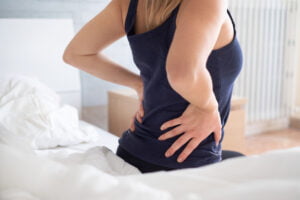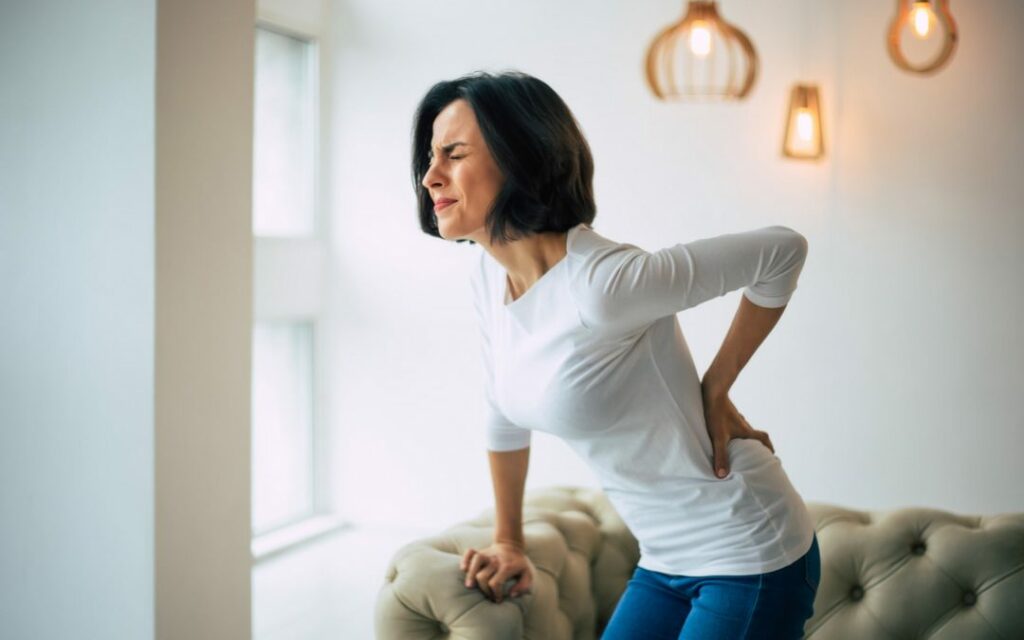Lower back and hip pain is a prevalent issue, especially among women. It can significantly impact daily life and hinder mobility, leading to decreased productivity and overall well-being. Understanding the causes of this pain and adopting appropriate strategies for relief and prevention is crucial for women of all ages. In this article, we will explore the common causes of female lower back and hip pain, lifestyle changes that can alleviate it, exercises for strengthening and flexibility, alternative treatments, nutritional considerations, managing pain during pregnancy, and coping with chronic pain.
Contents
Female Lower Back and Hip Pain

Female lower back and hip pain refers to the discomfort or pain experienced in the lower back and hip region by individuals who identify as female. This type of pain can vary in intensity and may be acute (short-term) or chronic (long-lasting). It can be caused by various factors, some of which are specific to females, while others are common to both genders.
The relationship between female lower back and hip pain is often interconnected due to the anatomical and biomechanical structures of the body. The lower back and hips are closely situated and share common muscle groups, nerves, and joints. As a result, issues in one area can lead to pain or discomfort in the other.
Here are some key points to understand the relationship between female lower back and hip pain:
- Muscular connections: Many muscles in the lower back and hips are interconnected and work together to support the body’s movement. If one group of muscles becomes weak or tight, it can affect the stability and function of the entire region, leading to pain in both areas.
- Nerve connections: The nerves that innervate the lower back and hip regions can overlap. For instance, the sciatic nerve, which runs through the lower back and down each leg, can be compressed or irritated, causing both lower back and hip pain (sciatica).
- Joint relationships: The hip joint and the joints of the lower back (lumbar spine) are near each other. Problems in one joint, such as osteoarthritis or a herniated disc in the lumbar spine, can refer to pain in the hip or vice versa.
Common Causes of Lower Back and Hip Pain in Women

Lower back and hip pain in women can be caused by various factors. Some of the common causes include:
- Muscular strain: Overuse, improper lifting, or sudden movements can lead to strained muscles in the lower back and hip area.
- Pregnancy: During pregnancy, hormonal changes and the increased weight of the growing fetus can put extra stress on the lower back and hips, leading to pain.
- Sciatica: Compression or irritation of the sciatic nerve, which runs from the lower back down the legs, can cause radiating pain from the lower back through the hips and into the legs.
- Osteoarthritis: The breakdown of cartilage in the hip joints or the lumbar spine can lead to pain and stiffness in both the lower back and hips.
- Herniated disc: When the soft center of a spinal disc pushes through a crack in the tougher exterior, it can compress nearby nerves and cause pain in the lower back and hips.
- Sacroiliac joint dysfunction: The sacroiliac joint connects the sacrum (base of the spine) to the pelvis. Dysfunction or inflammation in this joint can cause pain in the lower back and hips.
- Gynecological issues: Problems with the reproductive organs, such as ovarian cysts, endometriosis, or pelvic inflammatory disease (PID), can cause pain that may be felt in the lower back and hips.
- Spinal abnormalities: Conditions like scoliosis or other spinal deformities can lead to imbalances in the spine, causing pain in the lower back and hips.
- Bursitis: Inflammation of the bursae (small fluid-filled sacs) in the hip area can cause pain in the hips and may radiate to the lower back.
- Piriformis syndrome: The piriformis muscle, located in the buttocks, can sometimes compress the sciatic nerve, leading to pain in the lower back and hips.
Lifestyle and Ergonomics
Lifestyle and ergonomics play crucial roles in maintaining overall health and well-being, especially when it comes to preventing or managing issues like lower back and hip pain. Making positive lifestyle changes and following ergonomic principles can significantly improve comfort, reduce the risk of musculoskeletal problems, and enhance productivity. Here are some key aspects to consider:
- Maintaining a Healthy Weight: Managing body weight within a healthy range reduces the stress on the lower back and hips, decreasing the risk of developing chronic pain conditions.
- Proper Posture: Maintaining good posture while standing, sitting, and lifting is essential. Avoid slouching or arching the back excessively, as it can strain the muscles and ligaments in the lower back and hip area.
- Ergonomic Workstations: If you have a desk job, ensure that your workstation is ergonomically designed. Adjust your chair, desk, and computer monitor to promote a neutral spine posture. Use an ergonomic chair with lumbar support to reduce stress on the lower back.
Exercises for Strengthening and Flexibility
Strengthening and flexibility exercises can help improve the stability and function of the muscles around the lower back and hips. Here are some exercises that can be beneficial:
1. Bridge:
- Lie on your back with your knees bent and feet flat on the floor.
- Lift your hips off the ground, forming a straight line from your shoulders to your knees.
- Hold for a few seconds, then lower your hips back to the ground.
- Repeat for several repetitions.
2. Bird-Dog:
- Start on your hands and knees in a tabletop position.
- Extend your right arm forward while simultaneously extending your left leg straight back.
- Keep your core engaged to maintain balance.
- Hold for a few seconds, then return to the starting position.
- Repeat on the opposite side and continue alternating.
3. Cat-Cow:
- Begin on your hands and knees in a tabletop position.
- Inhale as you arch your back, lifting your head and tailbone (Cow pose).
- Exhale as you round your back, tucking your chin and pelvis (Cat pose).
- Flow between these two positions for several repetitions.
Physical Therapy and Alternative Treatments
Physical therapy and alternative treatments can be effective in managing lower back and hip pain, providing non-invasive approaches to pain relief and rehabilitation. These treatments aim to improve mobility, strength, and flexibility while addressing the underlying causes of the pain. Here are some common physical therapy and alternative treatments:
Physical Therapy
- Manual Therapy: This includes hands-on techniques performed by a physical therapist to manipulate and mobilize joints and soft tissues, reducing pain and improving flexibility.
- Therapeutic Exercises: Specific exercises tailored to your condition are designed to strengthen the muscles around the lower back and hips, improve posture, and enhance stability.
- Stretching: Targeted stretching routines can help improve flexibility and alleviate muscle tightness in the lower back and hips.
- Core Strengthening: Strengthening the core muscles can provide better support to the spine and help reduce lower back pain.
- Heat and Cold Therapy: Applying heat or cold to the affected area can help reduce inflammation, relax muscles, and alleviate pain.
Alternative Treatments
- Acupuncture: An ancient Chinese therapy involving the insertion of thin needles into specific points on the body to stimulate energy flow and relieve pain.
- Chiropractic Care: Chiropractors use manual adjustments to realign the spine, aiming to improve joint function and reduce pain.
- Yoga: Practicing yoga can improve flexibility, strength, and posture, promoting relief from lower back and hip pain.
- Massage Therapy: Therapeutic massages can help relax muscles, reduce tension, and enhance blood circulation.
- Pilates: Similar to yoga, Pilates focuses on core strength and flexibility, which can benefit individuals with lower back and hip pain.
Nutrition and Supplements
Proper nutrition and the use of certain supplements can play a role in managing lower back and hip pain. While they may not directly treat the underlying causes of the pain, they can support overall health and reduce inflammation, which may contribute to pain relief. Here are some nutritional tips and supplements that may be helpful:
Nutritional Tips
- Anti-Inflammatory Diet: Focus on consuming foods that have anti-inflammatory properties, such as fruits, vegetables, whole grains, nuts, seeds, fatty fish (rich in omega-3 fatty acids), and healthy fats like olive oil.
- Stay Hydrated: Drink an adequate amount of water throughout the day to keep your body properly hydrated.
- Maintain a Healthy Weight: If you’re overweight, losing excess weight can reduce stress on the lower back and hips, potentially alleviating pain.
- Limit Processed Foods: Reduce or avoid processed foods, sugary snacks, and high-calorie beverages, as they can contribute to inflammation and weight gain.
Supplements
- Omega-3 Fatty Acids: Fish oil supplements can provide omega-3 fatty acids, which have anti-inflammatory properties. They may help reduce pain and stiffness in some individuals.
- Turmeric/Curcumin: Curcumin, the active compound in turmeric, has potent anti-inflammatory effects. It is available in supplement form and may be beneficial for reducing pain and inflammation.
- Glucosamine and Chondroitin: These supplements are often used to support joint health and may help with pain associated with osteoarthritis.
- Boswellia: Also known as Indian frankincense, Boswellia is an herbal supplement with anti-inflammatory properties that may help relieve joint pain.
- Vitamin D: If you have a deficiency in vitamin D, a supplement can be beneficial for bone health and pain management.
Preventing Pain During Menstruation

Menstrual pain, also known as dysmenorrhea, is a common issue experienced by many women during their menstrual cycle. While it may not always be possible to eliminate menstrual pain, there are several steps you can take to help prevent or reduce discomfort during menstruation:
1. Maintain a Healthy Diet: Consuming a balanced diet with plenty of fruits, vegetables, whole grains, and lean proteins can help support overall health and may reduce inflammation and bloating during menstruation.
2. Stay Hydrated: Drinking enough water can help reduce bloating and water retention, which are common during menstruation.
3. Regular Exercise: Engaging in regular physical activity can help reduce menstrual pain by increasing blood flow and releasing endorphins, which are natural pain relievers. Light exercises like walking, swimming, or yoga can be beneficial.
4. Heat Therapy: Applying a heating pad or taking a warm bath can help relax the muscles and alleviate menstrual cramps.
Conclusion
Female lower back and hip pain can significantly impact a woman’s life, but it doesn’t have to be a constant struggle. By understanding the causes and adopting appropriate strategies for prevention and relief, women can reclaim control over their lives and enjoy pain-free mobility. Whether it’s through exercise, alternative treatments, proper nutrition, or mental well-being, taking proactive steps toward pain management will lead to a healthier and happier existence.
If you’re experiencing Hip pain, physical therapy for hip pain at PhysioMantra can help: Book an online physical therapy session.



